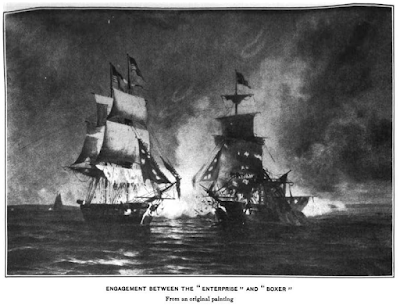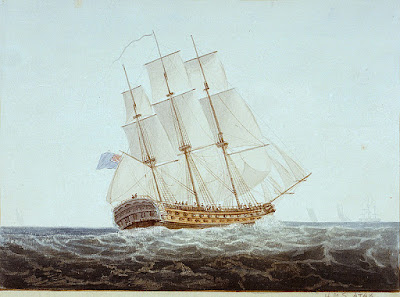Britain’s legal
abolition of her slave trade in 1807 is one of the most admirable actions in her
history, making it illegal for British subjects to deal in slaves or to carry
them in British ships. The penalty for so doing was initially only a fine but
as the trade was so profitable that this had relatively little impact. In 1811
however the penalty was increased to transportation four fourteen years. This
involved being sent to Australia as a convict and set to work there either
directly for the government or in indentured service to a settler. Return to
Britain during this term was punishable by death. Increasing scarcity value
tended to make trading even more profitable for successful operators and so this
penalty did not prove fully effective. The decision was then taken in 1824 to
treat slave-trading as piracy and therefore punishable by death. Thirteen years
later this was reduced, once more back to transportation, but now for life, not
just fourteen years. In 1837, however, the punishment inflicted on British
subjects for trading in slaves was changed to transportation for life.
During these
years however other nations also abolished the trade – the United States in 1807
(but at sea only), Portugal in 1810, Sweden in 1813, the Netherlands in 1814 and
France in 1817. It should be noted that slavery per se continued to exist where
it was already established. Britain was the first in implementing full
emancipation, in 1833, while Spain was to be the last, in 1886. Several of
these nations were however notably unenthusiastic – to say the least – about
enforcement. Cuba and Brazil in particular continued to have a high demand for
slaves and Spanish and Portuguese slaver vessels figure prominently in all accounts of suppression. Out
of the estimated 11 million total slaves who survived shipment from Africa to the
Americas, some 4 million, nearly 40
percent of the total, went to Brazil.
 |
| Slaves being shipped out to a vessel offshore - a Royal Navy cruiser has been spotted on the horizon (left) - a quick getaway is desirable! |
 |
| Typical anti-slaving action - the Capture of Spanish ship Dolores by HMS Ferret, 1816 Painting by W.J.Huggins (1781-1845) |
Between 1815,
at the end of the Napoleonic Wars, and 1860, the Royal Navy’s Anti-Slavery
Squadron – most of the time based at what would become Lagos, Nigeria – carried
the greatest burden in combating the Atlantic Slave Trade. When this declined,
British efforts, up to around 1890, were shifted to combatting the Indian Ocean
slave trade between East Africa and Arabia. An earlier blog (see reference at the end of this
article) pointed out just how dangerous such service could be – an annual
mortality rate of 55 per 1,000 men for Royal Navy crews operating off West
Africa, compared with 10 for fleets in British waters or in the Mediterranean.
Disease, particularly malaria, was a killer, but so too were the ruthless masters
and crews of the slave ships they were chasing. These vessels were usually
small, fast and often armed, and the condition in which their human cargos were
confined shamed Humanity. There were cases of some 900 people in a single hold
and decks being battened down during storms. Stories were told of more than a third
of the slaves being found dead from suffocation when the hatches were opened
after a hurricane and that rather than have the trouble of hauling up the dead
bodies, the hatches were battened down again. A third more might die during the
remainder of the voyage. The previous blog mentioned told of one instance that
typified the dangers to the Anti-Slavery Squadron and events in 1847, as
described below, were to provide another.
 |
| Typical 19th Century slaver taking on captives off West Africa Small and fast, her raked masks give a hint of speed that may be enough to outrun naval vessels |
In July 1847 a Brazilian slaver, the brigantine Romeo Primero, had been captured off
West Africa by the brig-sloops HMS Waterwitch
and HMS Rapid. The procedure,
once the slaves had been released, was for the fate of the ship – usually
resale by the government – was to be decided by a court established for the purpose.
In this instance the “adjudication” was to take place at the island of St.
Helena. The Romeo Primero was being sailed
by a Royal Navy crew consisting of a Lieutenant W.G. Mansfield and four seamen.
The four Brazilian slavers who had manned the vessel before capture were kept on
board as prisoners but – unwisely – were allowed the freedom of the ship during
daytime. Unfavourable winds caused Mansfield
to decide to abandon the attempt to reach St. Helena and to head instead for the
nearer British base in Sierra Leone.
Around midday on 11th August Mansfield was on deck, presumably
at the helm, two of the British seamen were aloft and the two others were
sleeping in their bunks in the same space as the small-arms were stowed. Why
Mansfield and his men had not carried their weapons at all times is unclear –
it would seem to have been a wide precaution in the circumstances. One of the
prisoners now moved up behind the unsuspecting Mansfield and attacked him with
an axe used for chopping firewood. The other three prisoners simultaneously attacked
the seamen in their bunks, wounding both.
They managed somehow managed to get on deck and here one of the two died
of his injuries. Lieutenant Mansfield, meanwhile,
had survived the initial attack and had grabbed a piece of firewood to defend
himself. A prisoner armed with a cutlass now attacked him and inflicted nine separate
wounds, their severity mitigated only by the fact that Mansfield was wearing a
greatcoat. The two sailors – both of them unarmed – who had been aloft now
arrived on deck and Mansfield, weak from profuse bleeding, struggled towards them.
The surviving man who had been sleeping below had also reached them. None were
armed and there was nothing for it but to attack their attackers with their
bare hands. It says much for the strength of the seamen of the era that this proved
successful. One of the prisoners was thrown overboard in the scuffle and the others
were overpowered. The seamen were about
to send the three remaining after him when Mansfield, who was all but
unconscious, revived enough to order them to be kept alive so as to face trial
at Sierra Leone.
 |
| Freetown in this period - a dangerous station, due to malaria |
Admirable as his behaviour was after being attacked one
cannot but regard Mansfield as having been anything other than lax and complacent
in the extreme. He recovered but it was due to his slackness that three of his
four men died and that he himself nearly went with them. One trusts that his experience
would have proved a warning to other officers assigned similar tasks. It is
therefore with surprise that one learns that he was promoted to Commander within
the year!
To read more about the Anti-Slavery Squadron, “Slavers,
Piracy, Shipwreck, Survival & Injustice: The Royal Navy off West Africa
1845” click here.
For an account of another desperate
encounter with slavers in this period, you may be interested in this account of
the life of the spectacular – but now largely forgotten – Victorian naval hero,
Hobart Pasha. His unlikely career included chasing slavers, service in the
Crimean War in the Royal Navy, an encounter with the Pope, blockade-running for
the Confederacy in the American Civil War, dealing in ladies' foundation
garments and leadership of the Turkish Ottoman Navy. Click here to read about him.
-----------------------------------------------------
Interested in taking your own first steps towards writing fiction?
I'll be speaking at the Weymouth
Leviathan Maritime Literary Festival in March next year and during it I’ll also
be running a workshop on plot-development for aspiring writers. If you're
interested in writing fiction yourself this might help you take the plunge! To
mix metaphors, the proverb says that the journey of a thousand miles starts
with a single step. I hope we'll do better than that - perhaps workshop
participants will get some ten miles along!
I'd be very happy if participants were to include fans of the Dawlish
Chronicles novels and readers of my regular blogs. The festival - the first of
its kind - promises to be a fascinating occasion. I'll be providing updates as
details are firmed up but on the meantime, if you're in the UK in 12th-13th
March period in 2016 please consider reserving a slot in your diary.





























